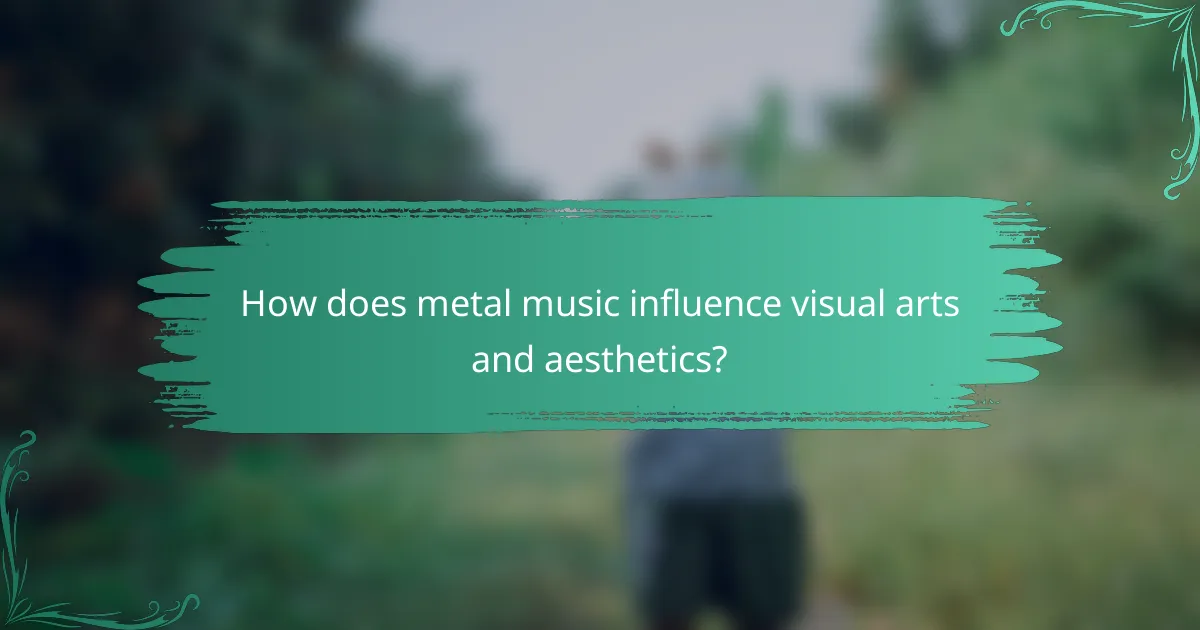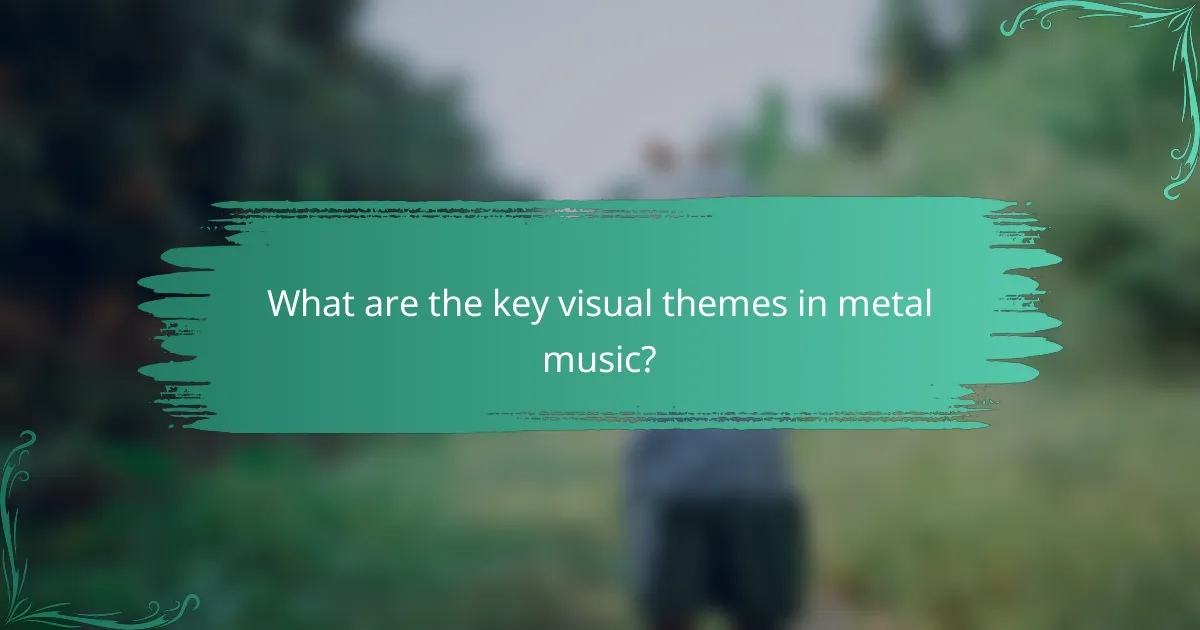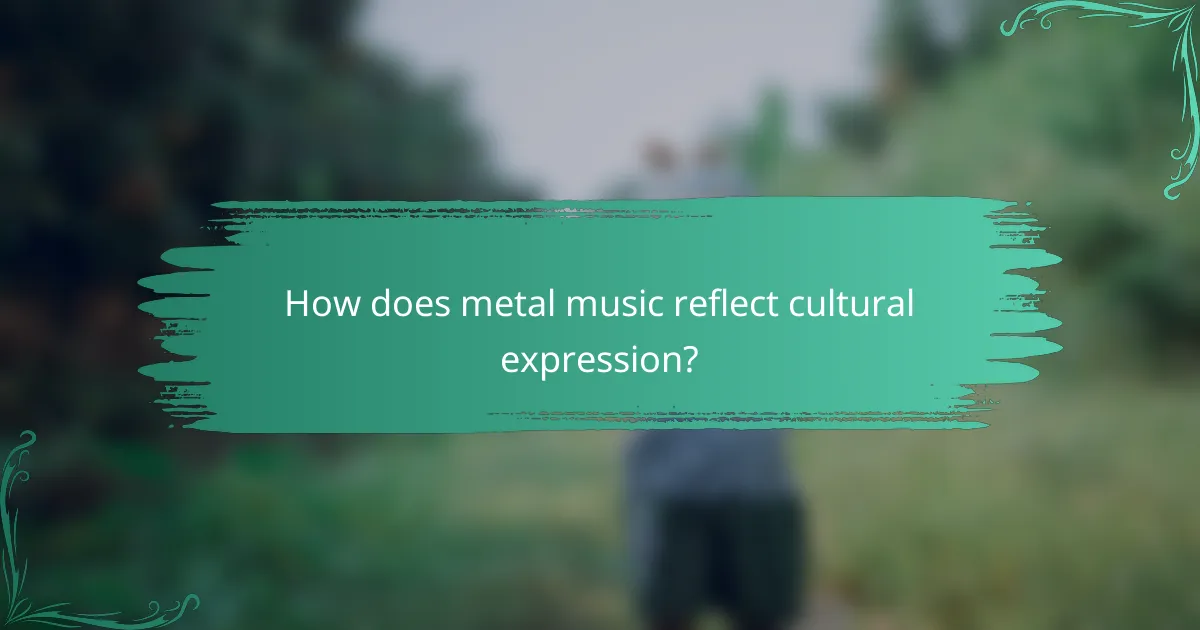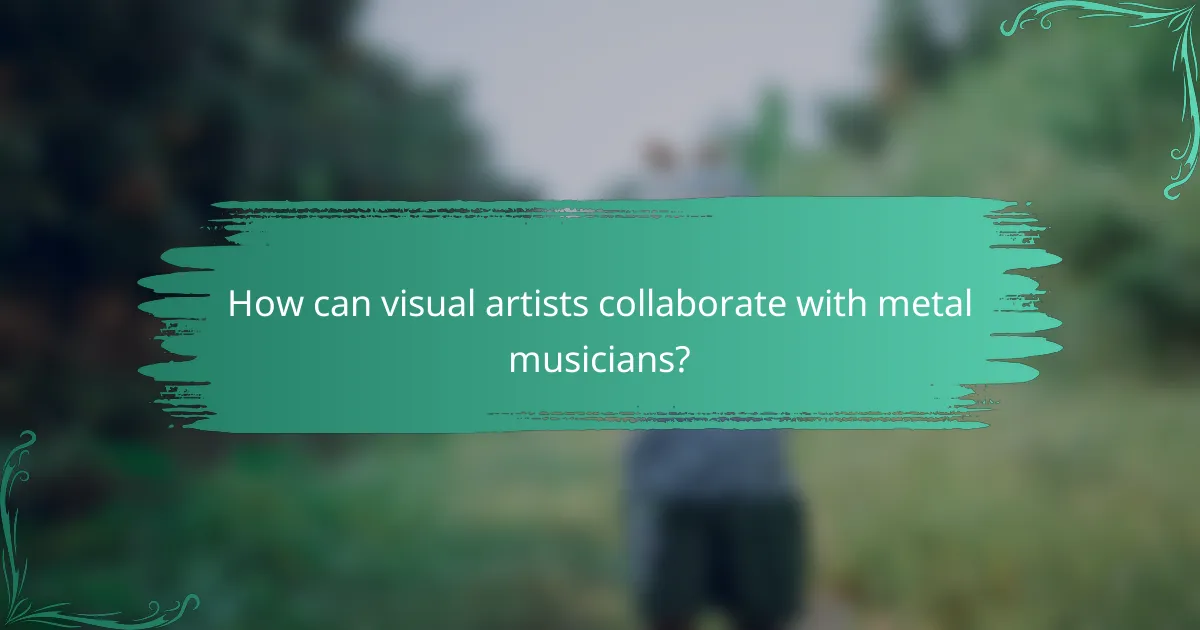Metal music profoundly influences visual arts and aesthetics, creating a unique style that mirrors its themes and cultural identity. This impact is showcased through various artistic forms, including striking album covers and merchandise that embody the genre’s intensity. Key visual elements often feature dark imagery and fantasy motifs, enhancing the genre’s appeal while serving as a powerful medium for cultural expression that resonates with its audience.

How does metal music influence visual arts and aesthetics?
Metal music significantly shapes visual arts and aesthetics by creating a distinct style that reflects its themes and culture. This influence is evident in various artistic expressions, from album covers to merchandise, each embodying the genre’s intensity and ethos.
Album cover art
Album cover art in metal music is crucial for establishing the band’s identity and conveying its themes. Covers often feature dark, intricate designs, vibrant colors, and fantastical imagery that resonate with the music’s intensity. Iconic examples include Iron Maiden’s “Eddie” and Metallica’s “Master of Puppets,” which have become synonymous with the genre.
When designing album covers, consider the band’s message and target audience. Collaborating with skilled graphic artists who understand metal aesthetics can enhance the visual impact and appeal.
Merchandise design
Merchandise design in metal music includes t-shirts, posters, and accessories that often feature bold graphics and logos. Effective merchandise not only promotes the band but also serves as a form of self-expression for fans. Popular designs often incorporate elements like skulls, mythical creatures, and gothic fonts.
To create appealing merchandise, focus on high-quality materials and unique designs that reflect the band’s style. Limited edition items can also create a sense of exclusivity and drive sales.
Music videos
Music videos in metal often showcase dramatic visuals that enhance the song’s narrative and emotional depth. These videos frequently include elaborate sets, special effects, and storytelling elements that captivate viewers. Bands like Slipknot and Rammstein are known for their visually striking and theatrical music videos.
When producing a music video, prioritize a strong concept that aligns with the song’s themes. Collaborating with experienced directors and cinematographers can elevate the production quality and overall impact.
Stage design
Stage design in metal performances is integral to creating an immersive experience for the audience. Elaborate setups often include elaborate backdrops, lighting effects, and props that reflect the band’s image and music. Festivals like Download and Wacken Open Air showcase some of the most impressive stage designs in the genre.
For effective stage design, consider the venue size and audience engagement. Incorporating interactive elements can enhance the live experience and leave a lasting impression on fans.
Graphic novels
Graphic novels inspired by metal music often explore themes of fantasy, horror, and rebellion, mirroring the genre’s lyrical content. These works can serve as a narrative extension of the music, allowing fans to engage with the band’s story on a deeper level. Notable examples include “The Metal” series and collaborations between bands and comic artists.
When creating a graphic novel, focus on a compelling storyline and strong visual style that complements the music. Collaborating with talented illustrators can help bring the narrative to life and attract both metal fans and comic enthusiasts.

What are the key visual themes in metal music?
The key visual themes in metal music often revolve around dark imagery, fantasy elements, and subculture symbols. These themes not only enhance the aesthetic appeal of the genre but also serve as a form of cultural expression that resonates with fans.
Dark imagery
Dark imagery is a hallmark of metal music, often reflecting themes of death, despair, and the macabre. This can include visuals of skulls, demons, and gothic landscapes, which create an intense atmosphere that complements the music’s tone.
Album covers, merchandise, and promotional materials frequently utilize dark imagery to evoke strong emotions and establish a distinct identity. Bands like Black Sabbath and Slayer exemplify this with their iconic artwork that captures the essence of their sound.
Fantasy elements
Fantasy elements in metal music often draw inspiration from mythology, literature, and epic tales. These visuals can include dragons, wizards, and enchanted realms, appealing to fans’ imaginations and creating a sense of escapism.
Many bands, such as Blind Guardian and Rhapsody of Fire, incorporate these themes into their lyrics and artwork, inviting listeners to immerse themselves in fantastical narratives. This blend of music and visual art enhances the overall experience of the genre.
Subculture symbols
Subculture symbols play a significant role in the visual identity of metal music, representing the community’s values and beliefs. Common symbols include the pentagram, the ankh, and various logos that signify different bands or movements within the genre.
These symbols often appear on clothing, tattoos, and fan art, fostering a sense of belonging among fans. Understanding these symbols can deepen one’s appreciation for the culture and its history, as they often carry profound meanings related to rebellion and individuality.

How does metal music reflect cultural expression?
Metal music serves as a powerful medium for cultural expression, often addressing social issues, personal identity, and historical contexts. Its themes resonate with listeners, reflecting their experiences and societal challenges.
Social commentary
Metal music frequently tackles social issues such as inequality, war, and political corruption. Bands like Rage Against the Machine and System of a Down use their lyrics to critique government actions and societal norms, encouraging listeners to question authority and engage in activism.
This genre’s raw energy and aggressive sound amplify its messages, making it a compelling vehicle for social commentary. Through their music, metal artists can spark discussions and inspire change within their communities.
Identity and community
Metal music fosters a strong sense of identity and belonging among its fans. The genre often attracts individuals who feel marginalized or misunderstood, creating a supportive community where they can express themselves freely.
Metal subcultures, such as thrash or black metal, provide distinct identities that fans embrace. Events like festivals and local shows further strengthen these bonds, allowing fans to connect over shared interests and experiences.
Historical influences
The roots of metal music are deeply intertwined with historical influences, drawing from various genres like blues, rock, and classical music. This blend creates a rich tapestry of sound that reflects the cultural backdrop of its time.
For example, the emergence of heavy metal in the late 1960s and early 1970s coincided with social upheaval and counterculture movements. Artists like Black Sabbath and Led Zeppelin incorporated themes of rebellion and escapism, mirroring the sentiments of a generation seeking change.
![]()
What role do iconic bands play in shaping metal aesthetics?
Iconic bands are pivotal in defining metal aesthetics through their unique visual styles, album artwork, and stage presence. They influence not only the genre’s sound but also its cultural expression, creating a distinct identity that resonates with fans globally.
Metallica’s influence
Metallica has significantly shaped metal aesthetics with their aggressive sound and powerful imagery. Their album covers, particularly for “Master of Puppets” and “The Black Album,” feature striking visuals that convey themes of control and darkness, setting a standard for future metal artwork.
Moreover, their live performances, characterized by elaborate stage setups and intense energy, have influenced how metal bands present themselves. This combination of music and visual art has made Metallica a benchmark for both sound and aesthetics in the genre.
Iron Maiden’s artwork
Iron Maiden is renowned for its iconic mascot, Eddie, who appears on nearly all their album covers. This character not only provides a consistent visual identity but also embodies the band’s themes of horror and fantasy, making their artwork instantly recognizable.
The band’s collaboration with artist Derek Riggs has resulted in some of the most memorable album covers in metal history, such as “The Number of the Beast.” These visuals enhance the storytelling aspect of their music, drawing fans deeper into the band’s narrative universe.
Black Sabbath’s legacy
Black Sabbath’s influence on metal aesthetics is profound, as they are often credited with establishing the genre’s dark themes and imagery. Their self-titled album cover, featuring a foreboding gothic church, set the tone for the visual style of heavy metal.
Their use of occult symbols and dark motifs in both music and visuals has inspired countless bands, reinforcing the connection between metal music and its visual representation. Black Sabbath’s legacy continues to resonate, shaping how new artists approach aesthetics in the genre.

How can visual artists collaborate with metal musicians?
Visual artists can collaborate with metal musicians by creating artwork that complements the music’s themes, enhancing the overall experience for fans. This partnership can take various forms, including album covers, stage designs, and promotional materials.
Types of Collaborations
Collaborations between visual artists and metal musicians can manifest in several ways. Common types include album artwork, where artists visually interpret the music’s mood and lyrics, and merchandise design, which can feature unique graphics for shirts and posters. Additionally, live performances often incorporate visual elements like projections or elaborate backdrops that reflect the band’s aesthetic.
Key Considerations
When collaborating, both parties should consider their artistic visions and how they align. Communication is crucial; artists must understand the music’s themes and emotions to create relevant visuals. Setting clear expectations regarding timelines, budgets, and creative control can help avoid misunderstandings.
Examples of Successful Collaborations
Many successful collaborations exist in the metal genre. For instance, the iconic artwork of Iron Maiden’s albums, created by Derek Riggs, has become synonymous with the band’s identity. Similarly, the visual style of bands like Slipknot, which includes masks and costumes, showcases how visual elements can enhance a band’s image and performance.
Tips for Effective Collaboration
- Establish a clear brief outlining the project’s goals and themes.
- Encourage open dialogue to share ideas and feedback throughout the process.
- Consider the audience’s perspective to ensure the visuals resonate with fans.
